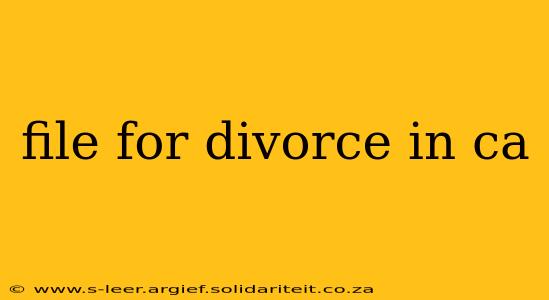Navigating a divorce can be emotionally and legally complex. This guide provides a comprehensive overview of the process of filing for divorce in California, addressing common questions and concerns. Understanding the steps involved can help you approach this challenging period with greater clarity and confidence.
What are the Grounds for Divorce in California?
California is a "no-fault" divorce state. This means you don't need to prove fault (such as adultery or abuse) to obtain a divorce. You only need to demonstrate that the marriage is irretrievably broken, meaning there's no reasonable prospect of reconciliation. This is typically shown by stating that irreconcilable differences exist between you and your spouse.
How Do I File for Divorce in California?
The process begins by filing a Petition for Dissolution of Marriage (or similar document if it's a legal separation) with the Superior Court in the county where you or your spouse has resided for at least three months and the county where you've resided for at least 60 days. You'll need to complete specific forms, including those related to:
- Personal Information: Names, addresses, dates of marriage, etc.
- Children (if applicable): Information about custody, child support, and visitation.
- Property Division: A detailed accounting of assets and debts.
- Spousal Support (if applicable): Requests for temporary or permanent spousal support.
You'll also need to pay filing fees, which can vary depending on your circumstances.
What Happens After I File?
Once you file, your spouse will be served with the paperwork. They then have a certain amount of time to respond (usually 30 days). After the response, you may begin the process of discovery, where both parties exchange information about assets, debts, and other relevant matters. This often involves:
- Financial disclosures: Providing detailed information about income, expenses, assets, and debts.
- Interrogatories: Written questions answered under oath.
- Depositions: Oral testimony given under oath.
What are the Different Types of Divorce in California?
While the fundamental process remains the same, there are variations depending on circumstances:
- Uncontested Divorce: Both spouses agree on all issues, simplifying the process significantly.
- Contested Divorce: Spouses disagree on one or more aspects, leading to a potentially longer and more complex process, often requiring mediation or court intervention.
- Summary Dissolution: A simplified process available only under specific circumstances, such as short marriages with minimal assets and no children.
How Long Does a Divorce Take in California?
The timeline varies considerably depending on the complexity of the case. An uncontested divorce might be finalized within a few months, while contested divorces can take much longer, sometimes exceeding a year or more.
What are the Costs Involved in a Divorce in California?
Divorce costs can range widely. They include court fees, attorney fees (which can be substantial), and potentially the costs of expert witnesses (e.g., appraisers, accountants). Mediation and other forms of dispute resolution can also add to the expense.
Can I Represent Myself in a Divorce?
While you can represent yourself (pro se), it's generally recommended to seek legal counsel, especially in complex cases involving significant assets, children, or contentious disputes. An attorney can guide you through the process, protect your rights, and help you achieve a favorable outcome.
Where Can I Find Legal Help?
Legal aid organizations and attorneys specializing in family law can provide assistance. You can also search online for attorneys in your area. Remember to thoroughly research and vet any attorney before engaging their services.
This information is for educational purposes only and should not be considered legal advice. Consult with a qualified California attorney for guidance on your specific situation.
